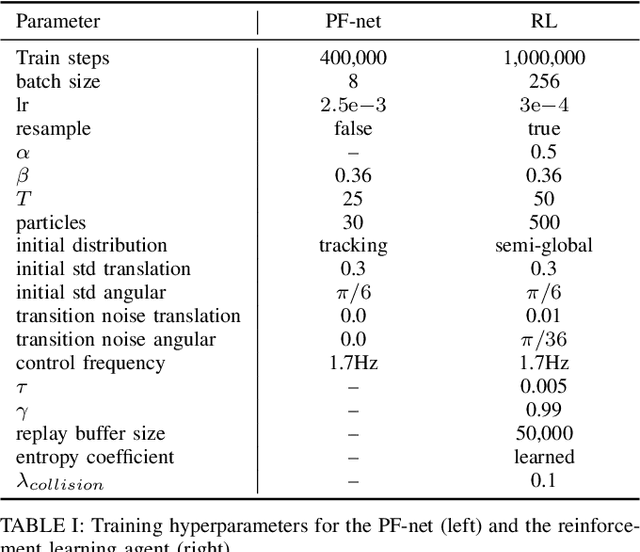Suresh Guttikonda
Learning a Terrain- and Robot-Aware Dynamics Model for Autonomous Mobile Robot Navigation
Sep 17, 2024Abstract:Mobile robots should be capable of planning cost-efficient paths for autonomous navigation. Typically, the terrain and robot properties are subject to variations. For instance, properties of the terrain such as friction may vary across different locations. Also, properties of the robot may change such as payloads or wear and tear, e.g., causing changing actuator gains or joint friction. Autonomous navigation approaches should thus be able to adapt to such variations. In this article, we propose a novel approach for learning a probabilistic, terrain- and robot-aware forward dynamics model (TRADYN) which can adapt to such variations and demonstrate its use for navigation. Our learning approach extends recent advances in meta-learning forward dynamics models based on Neural Processes for mobile robot navigation. We evaluate our method in simulation for 2D navigation of a robot with uni-cycle dynamics with varying properties on terrain with spatially varying friction coefficients. In our experiments, we demonstrate that TRADYN has lower prediction error over long time horizons than model ablations which do not adapt to robot or terrain variations. We also evaluate our model for navigation planning in a model-predictive control framework and under various sources of noise. We demonstrate that our approach yields improved performance in planning control-efficient paths by taking robot and terrain properties into account.
Single Frame Semantic Segmentation Using Multi-Modal Spherical Images
Aug 18, 2023Abstract:In recent years, the research community has shown a lot of interest to panoramic images that offer a 360-degree directional perspective. Multiple data modalities can be fed, and complimentary characteristics can be utilized for more robust and rich scene interpretation based on semantic segmentation, to fully realize the potential. Existing research, however, mostly concentrated on pinhole RGB-X semantic segmentation. In this study, we propose a transformer-based cross-modal fusion architecture to bridge the gap between multi-modal fusion and omnidirectional scene perception. We employ distortion-aware modules to address extreme object deformations and panorama distortions that result from equirectangular representation. Additionally, we conduct cross-modal interactions for feature rectification and information exchange before merging the features in order to communicate long-range contexts for bi-modal and tri-modal feature streams. In thorough tests using combinations of four different modality types in three indoor panoramic-view datasets, our technique achieved state-of-the-art mIoU performance: 60.60% on Stanford2D3DS (RGB-HHA), 71.97% Structured3D (RGB-D-N), and 35.92% Matterport3D (RGB-D). We plan to release all codes and trained models soon.
Context-Conditional Navigation with a Learning-Based Terrain- and Robot-Aware Dynamics Model
Jul 20, 2023Abstract:In autonomous navigation settings, several quantities can be subject to variations. Terrain properties such as friction coefficients may vary over time depending on the location of the robot. Also, the dynamics of the robot may change due to, e.g., different payloads, changing the system's mass, or wear and tear, changing actuator gains or joint friction. An autonomous agent should thus be able to adapt to such variations. In this paper, we develop a novel probabilistic, terrain- and robot-aware forward dynamics model, termed TRADYN, which is able to adapt to the above-mentioned variations. It builds on recent advances in meta-learning forward dynamics models based on Neural Processes. We evaluate our method in a simulated 2D navigation setting with a unicycle-like robot and different terrain layouts with spatially varying friction coefficients. In our experiments, the proposed model exhibits lower prediction error for the task of long-horizon trajectory prediction, compared to non-adaptive ablation models. We also evaluate our model on the downstream task of navigation planning, which demonstrates improved performance in planning control-efficient paths by taking robot and terrain properties into account.
Active Particle Filter Networks: Efficient Active Localization in Continuous Action Spaces and Large Maps
Sep 20, 2022



Abstract:Accurate localization is a critical requirement for most robotic tasks. The main body of existing work is focused on passive localization in which the motions of the robot are assumed given, abstracting from their influence on sampling informative observations. While recent work has shown the benefits of learning motions to disambiguate the robot's poses, these methods are restricted to granular discrete actions and directly depend on the size of the global map. We propose Active Particle Filter Networks (APFN), an approach that only relies on local information for both the likelihood evaluation as well as the decision making. To do so, we couple differentiable particle filters with a reinforcement learning agent that attends to the most relevant parts of the map. The resulting approach inherits the computational benefits of particle filters and can directly act in continuous action spaces while remaining fully differentiable and thereby end-to-end optimizable as well as agnostic to the input modality. We demonstrate the benefits of our approach with extensive experiments in photorealistic indoor environments built from real-world 3D scanned apartments. Videos and code are available at http://apfn.cs.uni-freiburg.de.
 Add to Chrome
Add to Chrome Add to Firefox
Add to Firefox Add to Edge
Add to Edge